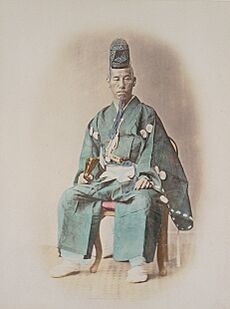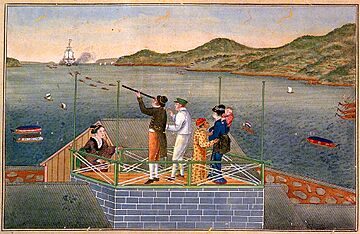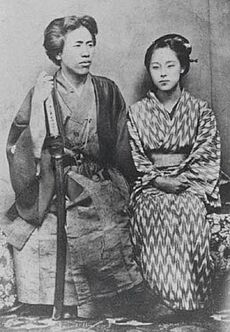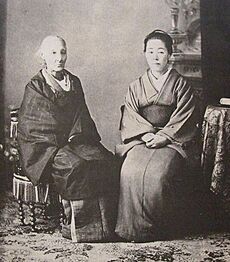Kusumoto Ine facts for kids
Quick facts for kids
Kusumoto Ine
|
|
|---|---|
 |
|
| Born |
Shiimoto Ine
31 May 1827 |
| Died | 27 August 1903 (aged 76) |
| Other names | O-Ine, Itoku |
| Occupation | Physician |
| Parent(s) |
|
| Relatives | Alexander von Siebold, Heinrich von Siebold |
Kusumoto Ine (楠本 イネ, 31 May 1827 – 27 August 1903) was a pioneering Japanese doctor. She was the very first woman in Japan to become a doctor of Western medicine.
Ine was the daughter of Kusumoto Taki from Nagasaki and a German doctor named Philipp Franz von Siebold. Her father worked on Dejima, a special island where foreigners were allowed to live during Japan's long period of seclusion from the rest of the world. People often called Ine "O-Ine" or "Dutch O-Ine" because of her connection to Dejima and the Western knowledge (called Rangaku) that came through the Dutch.
Her father, Siebold, had to leave Japan in 1829. But he made sure Ine and her mother were taken care of. He arranged for his students to help them. Ine's fame grew as she became a doctor. She even gained the support of a powerful feudal lord named Date Munenari. She studied all over Japan with many teachers. Ine never married. After Japan opened up to the world, she moved to Tokyo. In 1873, she helped with the birth of a child for Emperor Meiji's partner. Since her death, Ine has been the subject of many stories, plays, comics, and musicals in Japan.
Contents
Life and Career
Early Years and Family
Kusumoto Ine was born on May 31, 1827, in Nagasaki. Her father was a German doctor, Philipp Franz von Siebold. He lived on Dejima, an artificial island near Nagasaki. This island was the only place where foreign trade was allowed during Japan's time of self-seclusion. Siebold helped bring Western medical ideas to Japan. Ine's mother was Kusumoto Taki.
Ine lived with her parents on Dejima until 1829. Her father was accused of sharing secret maps and other information. He was forced to leave Japan on October 22, 1829. Taki and two-year-old Ine could not leave Japan. They waved goodbye from a small boat as his ship sailed away. Soon after, Taki married a man named Wasaburō.
Siebold was a wealthy man. He left sugar for Taki and Ine to help them. He also arranged for his students to look after them. He sent Ine books to learn Dutch grammar. Learning Dutch was important for studying Western knowledge in Japan at that time. Siebold's students also helped with Ine's education. There is a story that Ine ran away at age 14 or 15. She wanted to study medicine with one of Siebold's students, Ninomiya Keisaku. He was under house arrest in Uwajima Domain because of his connection to Siebold.
Becoming a Doctor
Ine officially began her medical training in 1845. She started studying obstetrics (the care of women during childbirth) in Okayama Domain. She learned from another of Siebold's students, Ishii Sōken. Ninomiya Keisaku helped her get this opportunity. Ine stopped her studies with Sōken in 1851. She returned to Nagasaki and gave birth to a daughter in 1852. She named her daughter Tada, meaning "free." This name showed that she felt heaven had given her this child "for free." Ine did not want Sōken to be involved in Tada's life.

Ine continued her studies in Nagasaki with Abe Roan. In 1854, she left Tada with her mother. She went with Ninomiya Keisaku's nephew, Mise Shūzō, to study with Keisaku in Uwajima. The lord of Uwajima, Date Munenari, strongly supported Western learning. In 1856, Keisaku had a stroke. He returned to Nagasaki with Ine and Shūzō.
Japan's period of seclusion ended in 1854. In 1859, Nagasaki became an open port for trade. The Dutch moved their consulate from Dejima to Edo (now Tokyo). Siebold received a pardon and returned to Nagasaki on August 4, 1859. He brought his 13-year-old son, Alexander, from his German marriage. Shūzō became Siebold's student, translator, and assistant. He also taught Japanese to Alexander. Ine first lived in her father's house. But their relationship was difficult, partly because of her Dutch language skills. Ine soon moved out. She worked closely with Shūzō, who helped her communicate with his excellent Dutch. Her father's good reputation helped her find her own patients. In April 1862, Siebold had to return to Europe and never came back to Japan.
Ine kept learning from Dutch doctors in Nagasaki. One of them was J. L. C. Pompe van Meerdervoort. He praised her skills in his writings. In 1861, Van Meerdervoort started the first Western-style hospital and medical school in Japan. It was called the Nagasaki Yōjōsho. The Japanese government (called the bakufu) supported it. Ine attended classes in the women's ward and helped with operations there.
Ine's good reputation and connections in the Western-learning community helped her gain the support of Date Munenari. His favor also extended to her daughter, Takako. Because Takako had both German and Japanese blood, she might face discrimination. So, Munenari had her change her name to Kusumoto Itoku. He gave Ine a small official payment of rice. She was expected to be ready to serve in the women's areas at the castle. Ine was one of three doctors present when Munenari's wife, Yoshiko, gave birth in 1867. Ine had a busy practice in Uwajima. She traveled often between Nagasaki and Uwajima during the 1860s. Munenari also helped her father and Shūzō. They were arrested in 1861 in Edo by groups who were against foreigners. Shūzō was released in 1865. He returned to Uwajima, where he married Takako in 1866.
Ine's mother died in 1869. Around this time, Ine studied obstetrics in Nagasaki with Antonius Bauduin. He was a pioneer in a type of surgery called ovariotomy. He was later appointed to the Tōkō national medical school in Tokyo. Tokyo had just been renamed from Edo, and the Emperor had moved there after the Meiji Restoration. After other moves, Ine also settled in Tokyo. There, she met Takako's half-brother, Ishii Kendō. Ine stayed in touch with her half-brother Alexander in Tokyo, who worked for the British government. Another half-brother, Heinrich, worked as an interpreter for the Austro-Hungarian government since 1869.
Later Life and Legacy
Kendō and Shūzō received important positions in Tokyo. In 1873, Ine used her connections with Fukuzawa Yukichi and other Western scholars. She attended the birth of a child for Emperor Meiji's partner, Hamuro Mitsuko. Both the child and Mitsuko died. But Ine received a large payment of 100 yen for her efforts. Shūzō and Takako moved to Osaka in 1876. Shūzō worked for the Osaka Hospital. In 1877, he became sick and died there. Takako became pregnant and gave birth to a boy in 1879. Ine adopted him as her heir and named him Shūzō. Takako married another doctor, Yamawaki Taisuke. They had three more children before he died in 1886.
Ine returned to Nagasaki. She earned her midwife's license in 1884. She moved back to Tokyo in 1889. She may have retired by 1895. At that time, her family moved into a Western-style house that Heinrich had built in Azabu. Ine died there on August 27, 1903. It is said she got food poisoning after eating freshwater eel and watermelon. She had the support of the Western medical and scholarly communities. Her students and fellow doctors respected her greatly. Her father also provided financial support.
People said Ine had fair skin, somewhat curly brown hair, and blue eyes. She never married. In her later life, she preferred not to talk about her mixed Japanese and German background.
Legacy
Ine is a main character in several novels. These include Kashin (1972) by Ryōtarō Shiba and Siebold's Daughter (1979) by Akira Yoshimura. She has also been featured in television dramas like Oranda no Ine (1970) and Kashin (1977). Another drama, O-Ine: Her Father's Name is Siebold, aired in 2000. Musicals based on Ine's life include Bakumatsu Girl: The Tale of Doktor O-Ine, which opened in Ehime in 2012.
A book for young people called The First Woman Doctor in Japan: Kusumoto Ine was published in 1992. It was written by Keiko Hamada and illustrated by Takashi Yorimitsu. The cartoonist Maki Masaki also adapted Ine's story into a comic called Siebold O-Ine in 1995. Masaki shows Ine with reddish hair. The story focuses on Ine's strong will. She faced challenges as a female medical student and as a child of mixed race.
See also
- Honorific speech in Japanese#Female names





